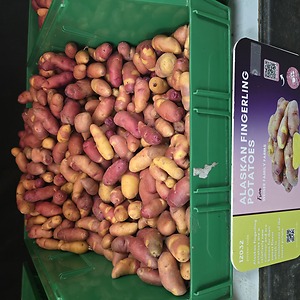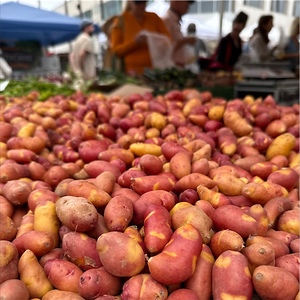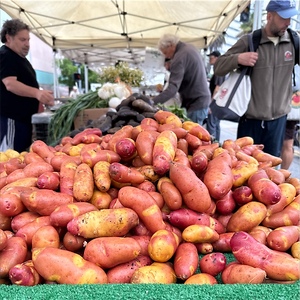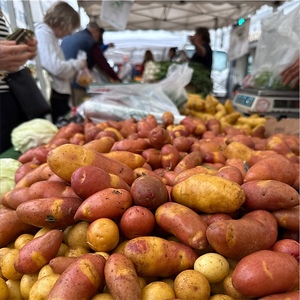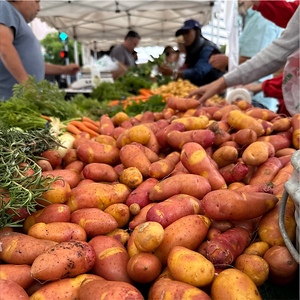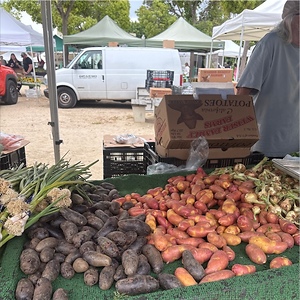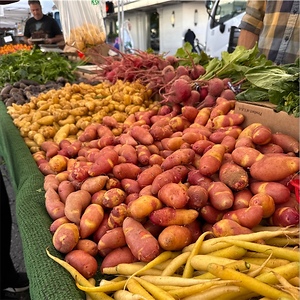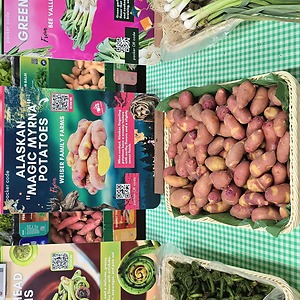


Alaskan Fingerling Potatoes
Estimated Inventory, lb : 0
This item was last sold on : 08/02/25
| Weiser Family Farms COD |
Description/Taste
Alaskan Fingerling potatoes are a slightly larger fingerling varietal than other commercial types and vary in size, depending on growing conditions. The tubers have an elongated, slender, oblong shape and often have a knobby appearance with bluntly curved ends. The skin is taut, thin, and semi-smooth, covered in some rough patches, giving the surface a lightly textured feel. Alaskan Fingerling potatoes have slightly indented eyes, creating visual bumps on the surface, and the skin showcases variegated golden yellow, red-pink, and tan hues. Underneath the surface, the golden yellow flesh is firm, slippery, and dense when raw, becoming soft, creamy, and smooth once cooked. Alaskan Fingerling potatoes have a somewhat waxy consistency, allowing them to hold their shape in culinary preparations. The variety is edible once cooked and has a mild, earthy flavor with a slightly sweet finish.
Seasons/Availability
Alaskan Fingerling potatoes are available year-round.
Current Facts
Alaskan Fingerling potatoes, botanically classified as Solanum tuberosum, are a specialty variety belonging to the Solanaceae, or nightshade family. The variety acquired its state-centric moniker as it was developed by a breeder in Alaska and is also well-known under the name Magic Myrna. Alaskan Fingerling potatoes are generally ready for harvest 85 to 110 days after sowing and are favored by growers for their disease resistance and high yields. A distinguishing trait of Alaskan Fingerling potatoes is their colorful skin. One plant can produce tubers with widespread color variation, giving the tubers increased visual appeal in fresh markets. Since their release to the public, Alaskan Fingerling potatoes have become a favorite fingerling variety among chefs and home gardeners. The tubers are known for their sweet taste and have a creamy texture reminiscent of a sweet potato. Alaskan Fingerling potatoes are versatile and can be incorporated into an array of savory cooked culinary dishes.
Nutritional Value
Alaskan Fingerling potatoes have not been studied for their nutritional properties. Fingerling potatoes, in general, are a source of fiber to aid the digestive tract and vitamins C and B6 to strengthen the immune system while contributing to energy production. Fingerling potatoes also provide antioxidants to guard the cells against free radical damage and help lower inflammation. Minerals in potatoes include potassium, calcium, iron, magnesium, phosphorus, and zinc. Potassium assists in balancing fluid levels within the body while replenishing electrolytes, while calcium and phosphorus support bone and teeth health. Iron develops the protein hemoglobin for oxygen transport through the bloodstream, magnesium helps the body control daily nerve functions, and zinc aids in building cells and tissues.
Applications
Alaskan Fingerling potatoes have a sweet and earthy flavor suited for cooked applications such as roasting, boiling, steaming, and pan-frying. The variety is favored for its creamy consistency and holds its shape well, making it a favored addition to soups, curries, and stews. Alaskan Fingerling potatoes are also notably roasted as their skin-to-flesh ratio creates a crisp exterior and a soft interior. Try roasting the tubers and serving them as a side dish to grilled meats, dice and add to salads, or slice and toss into fajitas and stir-fries. Alaskan Fingerling potatoes can be used in any preparation calling for fingerling potatoes, in general, and have a neutral flavor, complementing fresh herbs, savory sauces, and rich proteins. The variety is sometimes used for hashes or salt-style potatoes, which are tubers cooked in water with high salt concentrations. This preparation causes a crust to form, crisping the skin and developing a creamy flesh. There are many variations of salt-style potatoes known under varying names. The tubers can also be parboiled, smashed, and roasted as a crisp side dish. Alaskan Fingerling potatoes pair well with meats like pork, poultry, and beef, herbs including rosemary, thyme, parsley, and coriander, carrots, garlic, leeks, and shallots. Whole, unwashed Alaskan Fingerling potatoes have a shorter shelf life than other fingerling varieties and should be used within a week or two from purchase. The tubers should be stored in a cool, dry, and dark location, such as a cellar or pantry.
Ethnic/Cultural Info
In Alaska, this variety is more commonly known as Magic Myrna potatoes. The name was created by the variety’s breeder, Bill Campbell, and was labeled in honor of his wife, Myrna. Bill Campbell is known as Potato Bill, the Potato Man, and the Potato Guru throughout Alaska and has spent more than thirty years working as a potato disease control specialist for the state of Alaska’s Plant Materials Center. Campbell is an advocate for potato diversity and also frequently produces seed for the Alaska Certified Seed Potato Growers. His two most famous releases are Magic Myrna and Magic Molly potatoes, named after his wife and daughter. Both varieties are sold throughout the United States as specialty home garden fingerling potatoes.
Geography/History
Alaskan Fingerling potatoes were developed by breeder Bill Campbell near Palmer, Alaska. Potatoes were introduced to Alaska through Native peoples, European settlers, and traders, and have been grown in select regions of the state for several centuries. New varieties were carried to Alaska in various stages throughout history, and the tubers were known to be stored on sailing ships and eaten by miners during the Alaskan gold rushes. Potatoes can be grown across the state and are hardy plants that can readily adapt to long summer days and cooler temperatures. The history of Alaskan Fingerling potatoes is mostly unknown beyond its breeder name. The variety was commercially released as a new fingerling potato sometime in the late 20th or early 21st century. Today, Alaskan Fingerling potatoes are grown as a specialty variety across the United States by select farms and home gardeners. The variety is typically sold commercially through farmers' markets. In California, Alaskan Fingerling potatoes are grown by Weiser Family Farms.
Featured Restaurants
Restaurants currently purchasing this product as an ingredient for their menu.
| Chef Danielle Sharesse | San Diego CA | 619-892-2178 |
| Marriott Marina Kitchen | San Diego CA | 619-234-1500 |
| Catania La Jolla | La Jolla CA | 619-884-5350 |
| Merenda | Oceanside CA | 703-459-4145 |
| Mister A's | San Diego CA | 619-239-1377 |
| LANA | Solana Beach CA | 602-758-2596 |
| Little Victory Wine Market | Carlsbad CA | 310-738-3380 |
| Lauberge Del Mar | Del Mar CA | 858-259-1515 |
| Trust Restaurant | San Diego CA | 609-780-7572 |
| Addison Del Mar | Del Mar CA | 858-350-7600 |
| Bridges at Rancho Santa Fe | Rancho Santa Fe CA | 858-759-6063 |
| Chef Drew Mc Partlin | San Diego CA | 619-990-9201 |
| 31ThirtyOne by Deckman | San Diego CA | 619-495-9814 |
| Golden Door | San Marcos CA | 760-761-4142 |
| SD Continuing Education Culinary Arts | San Diego CA | 619-719-6924 |
| Dija Mara | Oceanside CA | 760-231-5376 |
| Nomad Donuts | San Diego CA | 619-431-5000 |
| Pizzeria Luigi | San Diego CA | 610-539-7025 |
| Lodge at Torrey Pines Main | San Diego CA | 858-453-4420 |
| Ctzn | Solana Beach CA | 858-925-7141 |
| Kettner Exchange | San Diego CA | 909-915-9877 |
| Brigantine Del Mar | Del Mar CA | 858-481-1166 |
Recipe Ideas
Recipes that include Alaskan Fingerling Potatoes. One



 Learn More...
Learn More...



